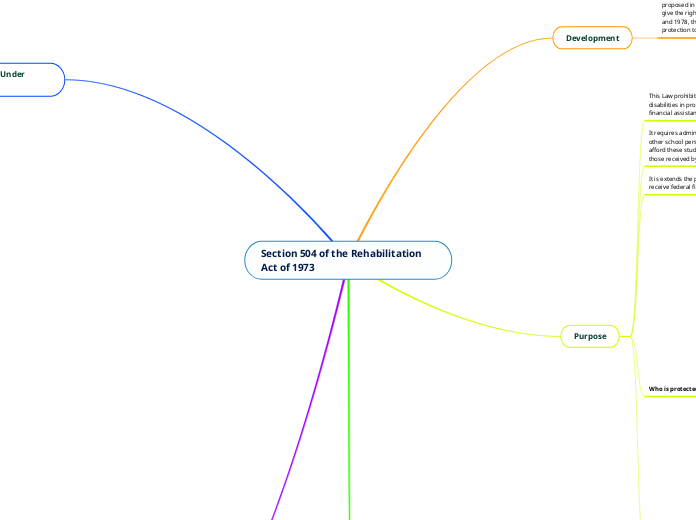Section 504 of the Rehabilitation Act of 1973
Major principles of Section 504
Procedural Safeguards
Schools must establish a system of due process procedures to be afforded to parents or guardians before taking any action regarding the identification, evaluation, or educational placement of a student with a disability who is believed to need educational services.
Evaluation and Placement Procedures
It's purpose is to prevent misclassification and misplacement.
FAPE
The definition of appropriate education under Section 504 is one of equivalency. That is, the educational services designed to meet the needs of students with disabilities must do so adequately as services designed to meet the needs of students without disabilities.
Extracurricular Activities
When school personnel offer extracurricular athletics in an equal opportunity to participate.
Avoiding discrimination
Appropriate responses include, investigating incidents, imposing discipline, providing training, and communicating with parents.
Comparable Facilities
When a school operates a facility for students with disabilities, the facilities and services must be comparable to regular education facilities and services.
Reasonable Accommodations
Program receiving federal financial assistance is required to provide reasonable accommodations to otherwise qualified individuals with disabilities.
I can relate to this as a year ago I took a class where I had to use a wheelchair, and I noticed that BYUI does not have a lot of accommodations for handicapped people. That is something that got me thinking because, for a student with a disability that requires a wheelchair, there are not a lot of options like getting to other buildings and the classrooms. Those are reasonable accommodations that need to take place.
Physical Accessibility
School academic and non-academic programs, structures, and activities must be physically accessible to students with disabilities.
School Districts Responsibilities Under Section 504
Enforcement of Section 504
Subtopic
Educational Obligations
Reevaluation
Section 504 requires that students be reevaluated periodically or before significant change in placement is made.
Placement
Placements options must include regular classrooms, regular classrooms with services, or special education and related services.
Educational Programming
A school has to provide a FAPE through regular education or special education programming or related aid and services.
Evaluation
Personnel trained should be the ones grading the tests. School should get parental consent, and notice to the parents about the procedural rights.
Identification
Student identified through Child Find
Administrative Responsibilities
Developing a System
Section 504 requires that schools annually take into count how to identify and locate children with disabilities who are not receiving the appropriate education they should, also the rights they encounter to have to. This is called Child Find.
This is something that I experienced during my Early Field Practicum. I was in a Special Education class and I just had to go with the teacher to different classrooms where we would do observations on the students that were identified as probably qualified for special education. We had to do a really good investigation and also evaluations to place them.
Conducting a Self-evaluation
The coordinator should do a self-evaluation of the school district to ensure that Section 504 is going well and there is no discrimination.
Grievance Procedure
First to have an informal discussion between parents and the Section 504 coordinator to attempt to resolve the dispute; second if the complaint is not satisfactorily resolved the parents should file a written grievance with the coordinator which will conduct an investigation and issue written report; third if this action is not solving the problem, the decision can be appealed to the chord board; and finally if a complaint to the school's board does not solve the problem, then a complaint to the OCR should be file.
Ensuring that Procedural Safeguards
During the evaluation process, notification should be given when eligibility is determined, when an accommodation plan is developed, and before there is any significant modification of the student's program.
Coordinator
The coordinator keeps the school district in compliance with the mandates of Section 504.
Subchapters of Regulations for Section 504
Subpart G
Procedures
Describes procedures for ensuring compliance with Section 504
Subpart F
Health, welfare, and social services
Prohibits discrimination in health, welfare, and social services receiving federal financial assistance
Subpart E
Postsecondary education
Prohibits discrimination in postsecondary programs receiving federal financial assistance
Subpart D
Preschool, elementary, and secondary education
Prohibits discrimination in preschool, elementary and secondary programs receiving federal financial assistance
While I was reading the book I noticed that it was mentioned that some states are not required to give services to students that are not meeting the school age. I wonder if a person with a disability under section 504 can also have the same services as they have at school, based on the disability.
Subpart C
Program accessibility
Describes accessibility and usability of facilities
Subpart B
Employment practices
Prohibits discrimination in employment practices
Subpart A
General provisions
States purposes, definitions
Purpose
Person who has a disability?
Part 2 and 3: A person who has a record of such an impairment or Who is regarded as having such an Impairment?
Record
Individuals are protected if they had a record an impairment, or have been incorrectly classified as disabled.
From my understanding, this is important that we have a record of how the student's impairment affected their education as teachers we can make accommodations. Also, we have to make sure we did not make mistakes in their placement. How long last effects will it have?
Otherwise qualified
This applies to public education, school age; when there is a competitive criteria are applied, it means that the criteria is met in spite of the disability; and in employment, the person needs to be qualified regardless of his or her disability.
Part 1: Definition
Affect a major life activity
breathing, walking, talking, seeing, hearing, learning, and taking care of oneself
Should be:
Mental
mental illness, intellectual disabilities, and learning disabilities.
Physical
arthritis, asthma, deafness, blindness, diabetes, Crohn's disease, multiple sclerosis, paralysis, cerebral palsy, epilepsy, cardiac problems, Ménière;s disease, chronic fatigue syndrome, kidney disease, Tourette's syndrome, and hyperthyroidism.
Who is protected?
Any person with a physical or mental impairment which substantially limits one or more of such person's major life activities, also has a record of such an impairment, or is regarded as having such an impairment.
I wonder if a student who is pregnant is protected by Section 504 or it was before getting pregnant, how this will affect her education? Would it be possible to also have her all the accessibilities that she might need?
It is extends the protections only in programs or services that receive federal financial assistance.
It requires administrators, teachers, school psychologists, and other school personnel to identify students with disabilities and afford these students educational opportunities equivalent to those received by students without disabilities.
This Law prohibits the discrimination against individuals with disabilities in programs and activities that receive federal financial assistance.
Development
In 1973, Section 504 of the Rehabilitation became a law. It was proposed in 1972, but it was not clear how the law was going to give the rights of protection to people with disability. In 1974 and 1978, the Amendments helped to extend civil rights protection to individuals with disabilities.









